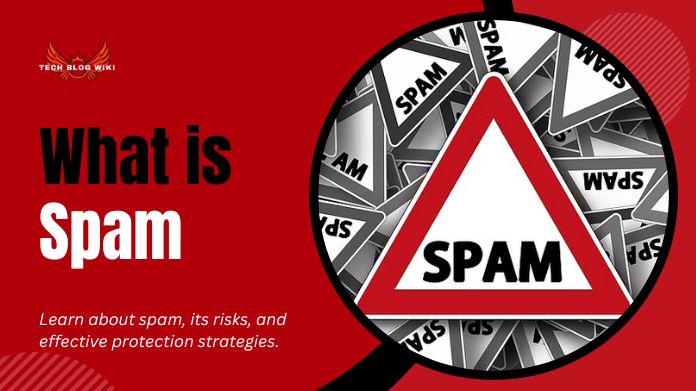In the vast landscape of the digital world, where communication flows incessantly, the term “what is spam” has become ubiquitous and often unwelcome. In electronic communication, spam refers to unsolicited and usually irrelevant or wrong messages sent over the internet, typically in large quantities.
These unwanted intrusions can manifest in various forms, from email spam to social media spam, phishing attempts, and more. As the digital realm grows, understanding what is spam and learning practical ways to protect oneself becomes paramount.
This Techblogwiki guide explores the intricacies of spam and its diverse manifestations and provides insights into robust strategies to shield against these digital nuisances.
Join us on a journey through the virtual landscape as we unravel the concept of what is spam and equip you with the knowledge needed to fortify your digital defenses.
What is Spam?

In electronic communication, spam refers to unsolicited and often irrelevant or inappropriate messages sent online. These messages are typically sent in large volumes to reach as many recipients as possible.
While the term originated from the abundance of canned “What is Spam” meat products, it has evolved to describe unwanted digital communications’ excessive and intrusive nature.
Spam can manifest in various forms, including:
- Email Spam: Unwanted and often malicious emails that flood inboxes with advertisements, phishing attempts, or irrelevant content.
- Social Media Spam: Unwanted or automated posts, messages, or friend requests on social media platforms, often aiming to promote products, services, or scams.
- Instant Messaging Spam: Unwanted messages sent through instant messaging services, promoting dubious products or attempting to deceive users.
- Comment Spam: Unsolicited and irrelevant comments posted on blogs, forums, or websites, often to drive traffic to external sites or spread malware.
- Phishing: Deceptive attempts to acquire sensitive information, such as usernames, passwords, or financial details, by posing as a reliable entity in emails or messages.
So, this is all about what is Spam. The proliferation of spam poses several risks, including privacy invasion, exposure to malware, and the potential for falling victim to scams.
Individuals and organizations employ various tools and strategies to combat spam, including spam filters, security software, and user education on recognizing and avoiding spam messages.
How to Identify Spam?

Identifying spam is crucial for maintaining a secure and clutter-free digital environment. Here are key indicators and tips to help you recognize and avoid spam:
1. Unknown Sender: Emails, messages, or friend requests from unknown or suspicious senders often indicate spam. Be cautious with communications from unfamiliar sources.
2. Unsolicited Emails: Genuine organizations typically do not send unsolicited emails asking for personal information or financial details. Treat unexpected requests for sensitive information with skepticism.
3. Misspellings and Grammatical Errors: Many spam messages contain spelling mistakes, grammatical errors, or awkward language usage. Legitimate communications from reputable sources generally maintain a higher level of professionalism.
4. Too Good to Be True Offers: If an offer seems too good to be true, it probably is. Be wary of unsolicited messages promising extraordinary benefits, prizes, or discounts, especially if you still need to initiate contact.
5. Urgent Calls to Action: Phishing emails often create a sense of speed, pressuring recipients to act quickly. Be cautious of messages that demand immediate responses or threaten consequences for inaction.
6. Suspicious Links: Hover over links in emails to preview the destination URL. If the link seems unrelated to the supposed sender or appears strange, it might be a phishing attempt. Avoid clicking on such links.
7. Unusual Attachments: Be careful when opening attachments, particularly if they come from unknown sources. Malicious software (malware) is often delivered through email attachments.
8. Generic Greetings: Legitimate organizations typically use your name in communications. If an email addresses you with generic terms like “Dear Customer” or “Dear User,” it could be a sign of spam.
9. Check the Sender’s Email Address: Verify the sender’s email address carefully. Some spammers use email addresses that mimic legitimate domains but have slight variations.
10. Verify Unexpected Communications: If you receive unexpected emails, messages, or friend requests claiming to be from reputable organizations, verify their legitimacy by contacting the organization directly through official channels.
11. Use Spam Filters: Enable spam filters provided by email providers. These filters automatically identify and redirect potential spam messages to a separate folder.
By staying vigilant and applying these guidelines, you can improve your ability to recognize and avoid spam, reducing the risk of falling victim to phishing attempts and maintaining a more secure online experience.
How Can You Protect Yourself From Spam?

Protecting yourself from spam requires a combination of vigilance, awareness, and security measures. Here are some effective strategies to safeguard against spam:
1. Use a Spam Filter: Enable and regularly update the spam filters provided by your email service provider. These filters help automatically identify and divert potential spam messages to a separate folder.
2. Keep Software Updated: Regularly update your operating system, antivirus software, and email client to help with the latest security patches. This helps protect against vulnerabilities that spammers might exploit.
3. Be Cautious with Personal Information: Avoid sharing personal information, susceptible details like passwords and financial data, in response to unsolicited emails or messages.
4. Verify Email Senders: Verify the legitimacy of email senders, especially if the communication seems unexpected or suspicious. Confirm the sender’s identity through official channels before taking any action.
5. Use Unique Email Addresses: Consider creating unique email addresses for different purposes. If one address receives spam, it won’t compromise your primary email account.
6. Employ Email Allowlisting: Whitelist known and trusted email addresses to ensure their messages reach your inbox without being filtered as spam.
7. Avoid Clicking on Suspicious Links: Refrain from clicking on links in emails or messages from unknown or untrusted sources. Hover over links to preview the URL and verify its legitimacy.
8. Use Two-Factor Authentication (2FA): Enable two-factor authentication whenever possible to add a layer of security to your accounts, making it more challenging for unauthorized access.
9. Educate Yourself and Others: Stay informed about common phishing tactics and educate yourself and others on recognizing and avoiding spam. Awareness is a powerful tool in preventing spam-related threats.
10. Secure Your Social Media Accounts: Adjust privacy settings on social media outlets to manage who can contact you and see your information. Be cautious with friend requests and messages from unknown individuals.
11. Regularly Review Privacy Settings: Periodically inspect and update the privacy settings on your accounts, ensuring that only authorized individuals can access your personal information.
12. Use Reputable Security Software: Install reputed antivirus and anti-malware software on your devices to detect and block potential threats, including spam and phishing attempts.
13. Report Spam: Report spam emails or messages to your email provider. This helps improve spam filters and contributes to the overall security of the email ecosystem.
Adopting a proactive approach and incorporating these protective measures into your digital habits can significantly reduce the risk of losing victim to spam and enhance your online security.
Final Note
In navigating the digital landscape, understanding what is spam becomes crucial for a secure online experience. Incorporating practical steps, such as using spam filters, safeguarding personal information, and staying informed, forms a robust defense against unwanted intrusions.
Regularly updating software, blocking suspicious links, and promptly reporting spam collectively contribute to a safer and more enjoyable online environment.
By embracing these practices and continually adapting to evolving digital threats, individuals can foster a culture of digital literacy and fortify their defenses against the persistent challenge of spam.






